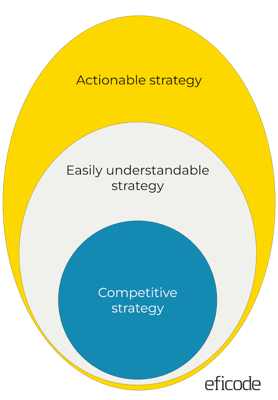Every product or service organization needs a good strategy. But strategies are easy to talk about and difficult to master.
But what makes a strategy successful?
I have consulted dozens of companies on product and services strategy, and I have a working, three-dimensional model that I will now share with you. If you use it, any strategy is far more likely to be successful.
Ready? Here we go.
First: Any well-working strategy needs to be:
-
Competitive
-
Easily understandable
-
Actionable

Far too often, the focus is on the core of the strategy — its competitiveness. But the other two components are just as important. And that’s where more companies go wrong. Their strategies fail because:
-
Employees that don’t understand the strategy can’t follow it.
-
If the strategy doesn’t help you to decide how to act in a situation, then what’s the use?
So any winning strategy is a sum of all three components. Fail at one of them, and you will fail at executing the strategy.
This is true for all types of strategy: company, technology, product, people, and so on.
Now that you know you need all three components, let’s have a quick look at each, and how to actually implement them.
Your strategy needs to be competitive
Hundreds of books have been written about the competitiveness of a strategy. Strategic thinking dates back hundreds of years, from classics such as Sun Tzu’s Art of War. These books offer great insights on how to build a winning strategy.
I won’t go into detail on the contents of the winning strategy — I will leave that to Sun Tzu and the gang. Let’s instead breeze through this at a meta-level.
Your strategy needs to account for:
-
Why the strategy is successful
-
How you plan to play to win
If you don’t explain the “why” and “how”, your strategy will run into trouble later, as it spreads across the organization and people need to understand it.
A key factor in your competitive strategy is to select the place in the market where you want to compete and find something that differs, or something else that makes you competitive in that market.
Your strategy needs to be easily understandable by all
In any winning organization, at the very heart, there is a common understanding of how and where success comes from. Strategy plays a key role here, so make sure people around the organization understand your strategy's key points.
Often, strategies are not actually understood, even though people know how to repeat the most important strategic mantras. In an MIT study, only around 25% of organizations’ top leaders understood the strategy. Meaning the remaining 75% of the leaders didn’t understand the strategy. When that’s the number for top leaders, we can only guess the number for other parts of the organization.
Here are two tips to make your strategy understandable around the organization:
-
Understanding comes from clarity. But most strategies include a lot of information, so make sure you can summarize the key points of your strategy into one or two slides.
-
The language and messaging affect how easy it is to understand by all. For it to work, you need proper reasoning of the strategic decisions behind the strategy.
Your strategy needs to be actionable
Many strategies fail on this one: they are not actionable. They don’t actually help when making decisions. But a great strategy helps make decisions at every level, from large investments to smaller everyday decisions.
Solve this by asking yourself these two questions:
-
Does the strategy provide guidance to decision makers?
-
What are the metrics to ensure the direction?
The strategy should have statements like “do this over that”. Even though there will always be exceptions, good mantras or principles make the strategy easier to grasp and act on.
Work starts once the strategy is ready
Succeeding with strategy starts after the strategy has been made. When the strategy is competitive, understandable, and actionable, implementation becomes easier. It will always require a lot of work and repetition, but when the structure of the strategy creates clarity, you are much closer to success.
Published: Sep 23, 2022
Updated: Apr 23, 2025

